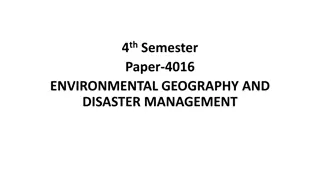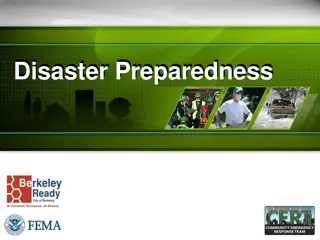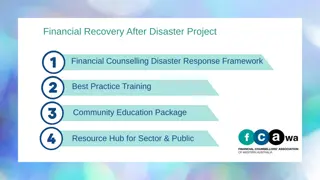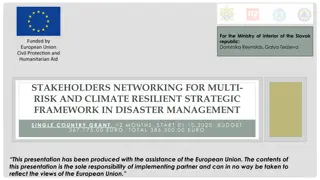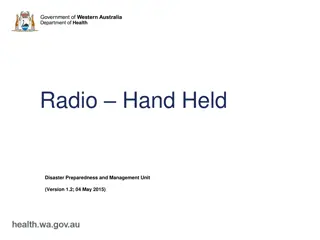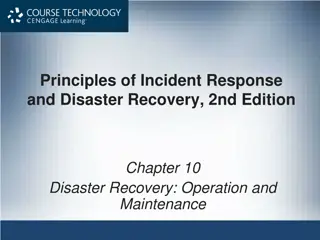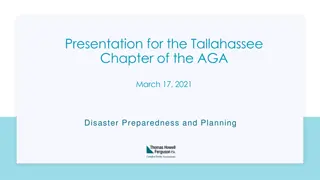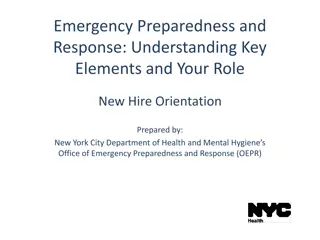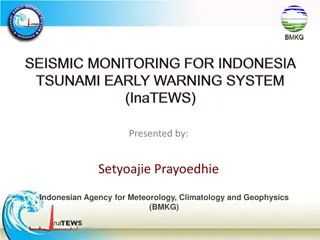Disaster Preparedness and Response: Importance and Strategies
Understanding and preparing for disasters, whether natural or human-made, is crucial for staying safe and healthy. The National Household Survey highlights the importance of having emergency supplies and action plans in place. Consider the types of disasters that could occur in your area, learn from past experiences, and recognize the diseases that could lead to public health emergencies. Organizations like FEMA and CDC offer resources and training to aid in disaster response, emphasizing the need for readiness and coordination in times of crisis.
Download Presentation

Please find below an Image/Link to download the presentation.
The content on the website is provided AS IS for your information and personal use only. It may not be sold, licensed, or shared on other websites without obtaining consent from the author.If you encounter any issues during the download, it is possible that the publisher has removed the file from their server.
You are allowed to download the files provided on this website for personal or commercial use, subject to the condition that they are used lawfully. All files are the property of their respective owners.
The content on the website is provided AS IS for your information and personal use only. It may not be sold, licensed, or shared on other websites without obtaining consent from the author.
E N D
Presentation Transcript
study of the distribution and control of health- related issues, including diseases Word Bank Bioterrorism leaving an area to escape a potential disaster Carbon monoxide the science of protecting and improving the health of people and their communities Epidemiology the use of biological agents for the purpose of terrorism (ex: anthrax, smallpox) Evacuation Outbreak an increase in the number of cases of a disease above what is normally expected in an area Public Health an odorless, colorless gas that is produced any time a fossil fuel is burned
Preparing for different types of disasters and emergencies before they happen is critically important 2019 National Household Survey conducted by the Federal Emergency Management Agency (FEMA) 80% have enough food and water to last 3+ days 48% have an emergency action plan Understanding Disaster Planning
1. What kinds of natural or human-made disasters could happen in your area? 2.Have you ever experienced a disaster? What helped you stay healthy and survive? If you haven t experienced a disaster, what do you think would be helpful? Think About It 3. What diseases could cause a widespread public health emergency?
CDC provides training programs, resources, and guidance to state, local, and international health departments to aid with disaster response CDC activates the Emergency Operations Center (EOC) to respond to immediate public health threats CDC s Center for Preparedness and Response (CPR) coordinates preparation, response, and recovery from major disasters CDC sometimes provides personnel such as the Global Rapid Response Team, which can deploy at a moment s notice to respond to health emergencies worldwide Disaster Planning and CDC
What types of emergencies does CDC respond to? Natural disasters like storms, tornadoes, flooding, earthquakes, wildfires, hurricanes, landslides, mudslides, extreme heat, and winter weather Human-made disasters such as chemical releases, radiation emergencies, and terrorism Disease outbreaks such as tuberculosis, Ebola, Legionnaire s disease, hepatitis, Salmonella, cholera, COVID-19, influenza, E. coli, measles Disaster Planning and CDC
1. What are two things you found surprising in this reading? 2. Why do outbreaks of infectious diseases commonly occur after a natural disaster? Think About It 3. What are two ways that CDC works with local and state health departments to help communities prepare for disaster?
From the Experts https://youtu.be/RwtEp84tGYQ
1. If you woke up to a fire and could save only 3 things, what would you grab? Why? 2. What do your 3 things tell you about your priorities in an emergency? How can you use this information to help you plan for future disasters? Think About It 3. How do you respond in an emergency: cool and calm or panicked and anxious? How will you incorporate your typical reaction style into your disaster plan?
Call to Action! 1. Develop a disaster plan. 2. Build a disaster kit. 3. Share your findings. Give it a Try Why do you think participation is important?
Define the problem Define the problem Define Define Research Research Do background research Do background research Requirements Requirements Specify requirements Specify requirements Use the Engineering Design Process Brainstorm Brainstorm Develop solutions Develop solutions Build Build Build a prototype Build a prototype Test Test Test and redesign Test and redesign Share Share Communicate results Communicate results
1. Develop a Disaster Plan - Research what kinds of disasters or emergencies might occur in your area - Develop evacuation or shelter-in-place plans for the disasters identified - Make copies of your plan and practice with other members of your household Give it a Try Brandmark of Ready Prepare. Plan. Stay Informed.
2. Build a Disaster Kit - Gather necessary supplies to build an emergency kit with supplies for your household - Pack your kit into an appropriate container and store where needed Give it a Try
3. Share Your Findings - Instagram @CDCmuseum Give it a Try



